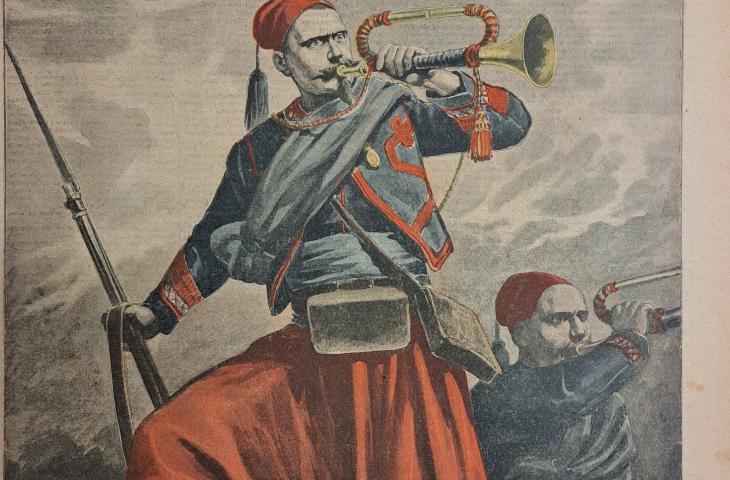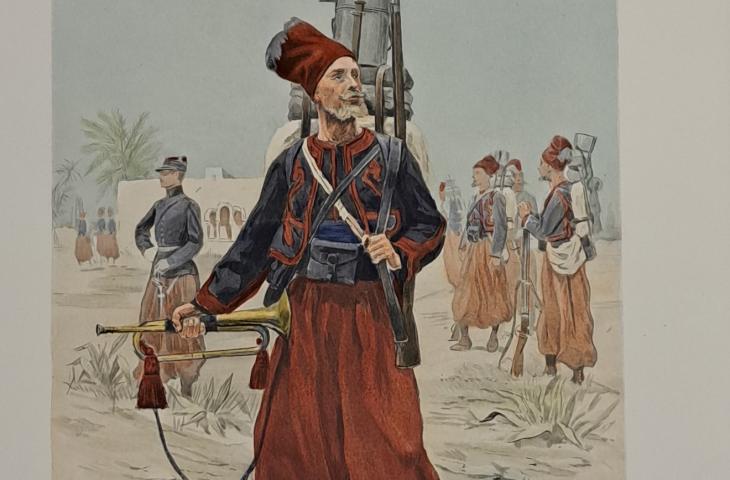November 2024
Bugle
Bugle, Adolphe Sax, Paris, 1862, inv. 1980.050
Detail inscription
Bugle, Adolphe Sax, Paris, 1862, inv. 1980.050
Illustration 1

Cover page of the illustrated supplement to Le Petit Journal, Paris, 1898, engraving, inv. MIMICO1992.00
Illustration 2
Light infantry, imagerie Bellange, Paris, around 1850, lithography, inv. MIMICO1992.048
Illustration 3

Zouave. Clairon. Tenue de campagne, Paris, 1902, engraving, inv. MIMICO1992.019
Description and use of the bugle
The bugle is a relatively rudimentary instrument, consisting of a simple brass tube, sometimes nickel-plated or silver-plated, bent back on itself and ending in a more or less wide bell. It is fitted with a mouthpiece on which the player must vibrate his lips to produce a few so-called harmonics or ‘natural’ notes, permitted by the laws of acoustics, in fact rarely more than five different notes. The instrument is mainly used as a means of signalling in a military context. It is also used in civilian batteries-fanfares, bands composed of natural brasswinds.
The sound of the bugle can be very powerful, although its conical bore gives it a less strident timbre than the trumpet. In the army, the bugle was traditionally used in infantry regiments, while the trumpet was used in cavalry regiments. Soldier buglers were trained to sound the various signals that governed military life as a whole, from unit designation calls to tactical signals (forward, halt, gymnastics step, assault, cease fire, gas alert, etc.), not forgetting service signals (reveille, attention, last post, call to meal, in the field, etc.). These signals were specific to each country. The ancient art of transmitting orders using musical instruments is known as celeustic.
Today, some of these signals can still be heard during ceremonies of protocol and tribute, such as the commemorations of the eleventh of November, or every day at the Menin Gate in Ypres.
The bugle and the Great War
The French-type bugle played a key role in an episode at the end of the Great War. On 7 November 1918, a German delegation headed towards the French lines to negotiate an armistice. The convoy advanced cautiously with a white flag and a German musician played the cease fire on a trumpet to avoid being fired upon.
At La Capelle (France, department of Aisne), the convoy was stopped by French troops and French buglers took over to sound the cessez le feu from the footboard of the first car. The plenipotentiaries and their escort would travel to the place where the armistice was signed, at Rethondes, four days later.
The first of these French buglers was Pierre Sellier, corporal bugler of the 171st infantry regiment. His ‘victory bugle’ is now on display at the Musée de l’Armée at Les Invalides in Paris. Georges Labroche, whose own ‘victory bugle’ has also been preserved, was one of the other French soldiers to sound the cessez le feu on this journey.
Finally, after the armistice was signed at 11am on 11 November 1918, this famous single-note call repeated at the four cardinal corners was played again by the other regimental buglers throughout the front line. It will be the signature sound that puts an end to the noise of a war that has cost millions of lives.
The MIM bugle: a historical model
The MIM bugle is older than Pierre Sellier’s, but has the same design. The tube, with its conical bore, makes a single complete turn on itself and has an elongated shape. Bearing the serial number 24401, it was produced in Adolphe Sax’s workshops in late 1861 or early 1862.
A Belgian active in Paris, Sax supplied instruments all over the world. The bugle in question was exported to Great Britain, where it was presented by Mrs James Evelyn in February 1862 to an unidentified person, probably from the 22nd regiment rifle volunteers, according to the inscriptions on the bell.
Its silver finish, the quality of its engraving and its perfect state of preservation suggest that it was an honorary instrument rather than one actually used in the field. The instrument entered the MIM collections in 1980 from a London antique dealer specialising in musical instruments.
Text: Géry Dumoulin